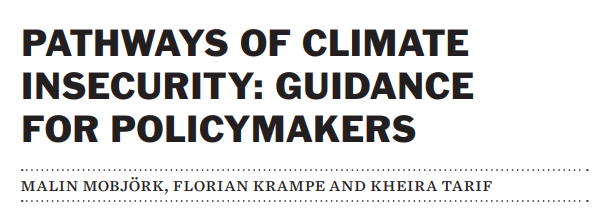Outlines four interconnected ways climate change can precipitate conflict. These are impacts on livelihoods, changes in migration and mobility, tactics of armed groups, and exploitation by elites. The report underscores the intricate relationship between climate change effects and security risks, emphasizing the necessity for a nuanced understanding of how climate change can engender insecurity.
The report elucidates how climate pathways can escalate conflict through local politics. Policymakers can identify key intervention areas to reduce peace risks by focusing on these pathways. It underscores the necessity of including local contexts in climate-related security analyses and guiding decisions in conflict-prone, climate-vulnerable regions.
- Livelihoods: Climate change can affect agriculture, causing economic issues for renewable resource-dependent communities and possibly escalating resource conflicts. This can exacerbate gender inequalities where women’s rights and resource management participation are restricted.
- Migration: Climate-induced migration, a response to climate threats, can be local due to disasters or towards areas with better livelihoods due to gradual changes.
- Armed Group Tactics: Climate change can intensify resource conflicts, such as land and water disputes, potentially driving people to join armed groups due to deteriorating livelihoods.
- Elite Exploitation: Climate change exploitation by elites can spur conflict, especially when governments favor certain groups, elevating violence risk. Marginalized women are notably vulnerable to climate impacts and violence.
Policymakers can use these pathways to mitigate violent conflict in climate-exposed regions by:
- Understanding the specific contexts in which climate change interacts with livelihoods, migration, armed group tactics, and elite exploitation to increase conflict risks.
- Incorporating the potential roles of elite groups in climate-exposed and conflict-affected regions to address social outcomes.
- Developing policies that enhance local governance, ensure equitable access to resources, and promote social cohesion to reduce conflict risks.
Overview
Why Pathways?
Emphasizes the importance of understanding and analyzing the pathways between climate change and conflict to address climate-related security risks effectively. By identifying and exploring the interconnected pathways of livelihoods, migration, armed group tactics, and elite exploitation, it becomes clear that policymakers can gain insights into how environmental changes linked to climate change impact the root causes and dynamics of violent conflict.
These pathways help policymakers understand complex relationships in conflict and climate-exposed regions. They integrate local context into climate change-related security and conflict risk analyses. Thus, they enable the creation of strategies to mitigate conflict, boost resilience, and foster sustainable management in climate-affected areas.
Pathways from Climate Change to Violent Conflict
Four pathways – livelihoods, migration, armed group tactics, and elite exploitation – reveal the link between climate-induced environmental changes and conflict roots. They show how climate change can enhance conflict risks, as seen in East and West Africa and South and South East Asia.
Understanding these pathways is vital for integrating climate-related security risks into policy analysis and strategy development for conflict prevention or mitigation related to climate change. This framework allows policymakers to create context-specific interventions that address the complex relationships between climate change and conflict, reducing insecurity risk in climate-sensitive and fragile regions.
Applying the Pathways Approach to Policymaking
Guides policymakers on using the pathways framework for mitigating climate-related security risks and conflict in climate-exposed regions. It underscores the impact of human actions on conflict dynamics due to climate change.
Policymakers at various levels, including country/operational, governmental/donor, and multilateral, can employ the pathways approach to incorporate short- and long-term processes into risk analysis and adapt responses to local contexts. Policymakers can use the pathways approach to assess, plan, and report on climate-related security risks at the country level. This can be integrated into existing analyses and reports, helping establish priorities for immediate programming and strengthening local dispute mechanisms and dialogue initiatives.
Secondly, the pathways framework can aid government/donor coordination across policy areas, identify comprehensive responses to climate-related security risks, ensuring context-specificity and inclusion of various policy communities. Lastly, the pathways approach can help policymakers globally address long-term climate priorities and promote specific responses to climate-related security risks.
Through engagement with multiple policy communities and coordination across different sectors, policymakers can strive for thorough responses to the intricate relationship between climate change and conflict to lessen the insecurity risk in climate-exposed and fragile regions.
Therefore. Nonetheless. However. Nevertheless. In conclusion. Henceforth. On the other hand. Hence. Furthermore. Therefore. Nonetheless. However. Nevertheless. In conclusion. Henceforth. On the other hand. Hence. Furthermore. Therefore. Nonetheless. However. Nevertheless. In conclusion. Henceforth. On the other hand. Hence. Furthermore.




